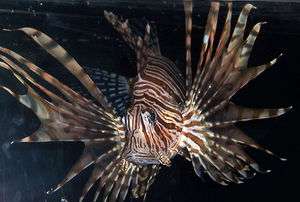Lionfish envenomation
Background
- From the Scorpaenidae family of camouflaged bottom-dwelling fish
- Fins have spine connected to venom glands which inject venom when agitated

Clinical Features
- Local erythema, ecchymosis, swelling
- Intense, sharp pain
- Australian stonefish can cause systemic toxicity:
- Hypotension, tachycardia, arrhythmia, syncope, vomiting, and pulmonary edema
- Symptoms peak at 60-90 minutes
- Duration: 1-2 days
Differential Diagnosis
Marine toxins and envenomations
- Toxins
- Stingers
- Venomous fish (catfish, zebrafish, scorpion fish, stonefish)
- Cone shells
- Lionfish
- Sea urchins
- Nematocysts
- Coral reef
- Fire coral
- Jellyfish (Cnidaria)
- Portuguese man-of-war
- Sea anemones
- Phylum porifera (sponges)
- Bites
Evaluation
- Clinical diagnosis, no specific testing available
- Consider radiography as retained foreign bodies are common[1]
Management
- Clean wound, update tetanus, remove retained tissue
- One fifth of wounds develop local infection, but prophylactic antibiotics remain controversial [2]
- Immerse extremity in hot water (45 C) for 30-60 minutes
- Stonefish envenomations with severe toxicity can be treated with antivenin obtained through poison control
Disposition
See Also
References
-
- Hobday D, Chadha P, Din AH, Geh J. Denaturing the Lionfish. Eplasty. 2016 May 23;16:ic20. PMID: 27298709; PMCID: PMC4892334.
-
- Hobday D, Chadha P, Din AH, Geh J. Denaturing the Lionfish. Eplasty. 2016 May 23;16:ic20. PMID: 27298709; PMCID: PMC4892334.
This article is issued from
Wikem.
The text is licensed under Creative
Commons - Attribution - Sharealike.
Additional terms may apply for the media files.